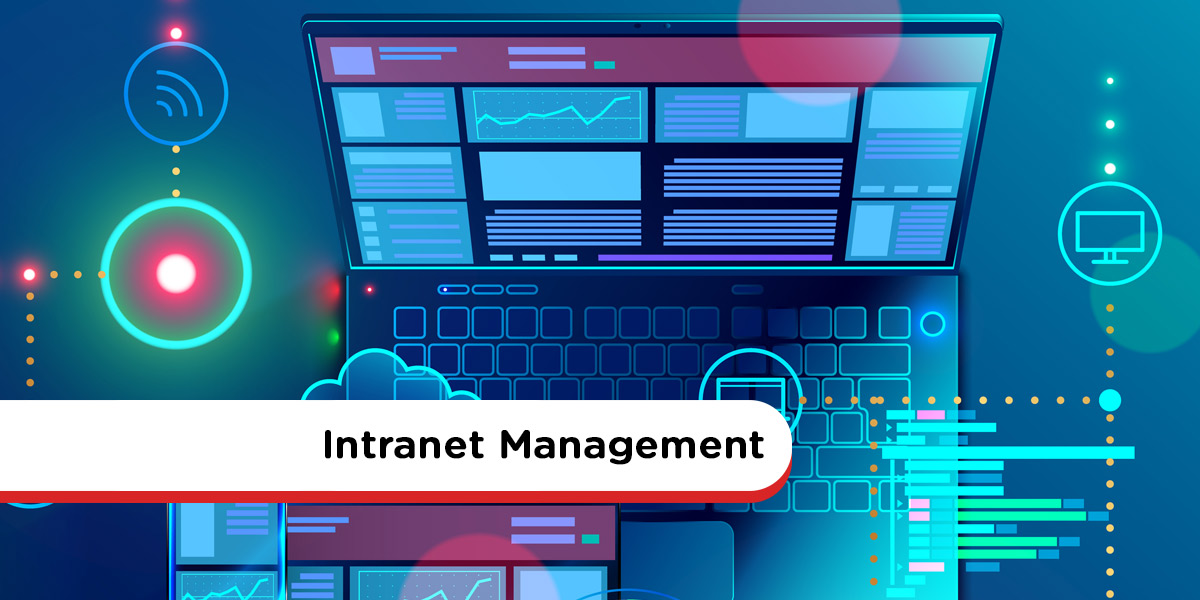
Your New Intranet Starts Here
Streamline communication, boost collaboration, and empower your team with MyHub's intuitive intranet solution.
Book a live demo now and experience the difference.
Take a Quick TourSo, your company intranet is up and running, and you’re delighted with the results. Internal communications have improved, team collaboration is thriving, and best of all, your employees genuinely enjoy using the platform. Congratulations! You’ve laid the foundation for a more connected and productive workplace, give yourself a well-deserved pat on the back.
However, launching the intranet is only the beginning. Long-term success depends on how well you manage and maintain your intranet. Even though modern platforms are intuitive and largely self-sufficient, every high-performing intranet is supported by a clear intranet management strategy.
The good news? It’s never too late to implement best practices. In this post, we’ll walk you through essential strategies for effective intranet management to ensure your platform continues to deliver long-term value and engagement.
Core Components of an Intranet Management System
Successful intranet administration involves several key responsibilities, grouped into four main categories:
- Information management – Includes intranet structure, content creation, review, and archiving processes.
- User management – Covers user permissions, notification settings, and access control such as password resets.
- Analytics – Involves developing performance metrics, analyzing usage statistics, and gathering staff feedback.
- Onboarding and support – Ongoing training, help desk support, and educating employees on new intranet features.
Best Practices for Intranet Information Management
The purpose of your intranet is to provide relevant, up-to-date content that employees can rely on. That doesn’t happen by accident, it requires careful planning and ongoing content governance.
A top intranet management strategy begins with a clear intranet content strategy. This strategy should define your goals, content structure, and publishing workflow. Include a sitemap that outlines different sections of your intranet to ensure a logical flow of information and a user-friendly experience.
Because multiple team members are often responsible for content creation, it’s crucial to have clear guidelines in place. Your strategy should address content approval processes, version control, metadata and tagging best practices, and even design and branding standards. These guidelines ensure consistency and searchability across the platform.
In terms of top notch intranet management, Content maintenance is just as important as content creation. Outdated or irrelevant content can harm credibility and hinder intranet engagement. That’s why you need a defined process for updating, archiving, or removing content regularly. For instance, displaying an obsolete health and safety policy could result in compliance issues. Avoid this by auditing content and setting clear review cycles.
One of the most effective tools for managing intranet content is a content calendar. It provides visibility into upcoming posts, responsible authors, and due dates. Whether it’s scheduling end-of-year financial updates or internal project results, a content calendar helps keep your team organized and accountable.
In summary, the following practices will improve your intranet’s content quality and usability:
- Develop a comprehensive intranet content strategy with clear goals and a detailed roadmap.
- Establish publishing guidelines for content creators to ensure consistency and compliance.
- Create structured processes for content auditing, reviewing, updating, archiving, or deleting outdated content.
- Implement a detailed intranet content calendar to track publication dates and responsibilities.
Intranet User Management: Secure and Efficient Access Control
Another fundamental intranet management task is user management. Most modern cloud intranet platforms come equipped with built-in user management tools. These intuitive tools allow administrators to easily set up users on the system and assign specific permissions, such as content creation, editing, or view-only access. Permissions can be configured for individual users or applied in bulk to entire teams or departments, streamlining administrative processes. Typically, an individual employee will have a tailored mix of permissions that align with their department and role responsibilities.
Protecting your intranet from internal security threats is a core part of an effective intranet management system. With the right user management system, you can enforce strong security protocols such as automated password resets and access restrictions. For instance, page-level permissions can be used to ensure only authorized users view sensitive or confidential information. Imagine a case where Bob in Marketing shouldn’t have access to HR’s confidential personnel files, proper access controls make that possible. Always ensure that you maintain full control over user access and deactivate accounts promptly when employees leave the organization.
Another key feature of user management is the setup of real-time intranet notifications. Keeping your workforce informed about company updates, new policies, and feature rollouts is critical. Some businesses utilize “hot news” buttons on the homepage to highlight essential updates, while others leverage team chat tools and #channels to spread messages. Newsletters summarizing recent posts and developments are also popular. Thanks to automatic time zone scheduling, these updates reach global teams promptly and effectively.
Key User Management Takeaways
- Utilize user tools to define roles, assign access permissions, and manage page visibility by team or department.
- Protect intranet content with the help of a password manager, enabling forced, automated password changes and restricting access to sensitive content.
- Implement a notification strategy to broadcast news, updates, and critical information across your workforce.
Intranet Management Analytics: Measuring Engagement and Performance
It’s impossible to improve what you can’t measure. That’s why intranet analytics is a crucial component of successful intranet management. Analytics tools give you data-driven insights into how well your intranet is performing and how engaged your employees are with the content.
With embedded analytics tools, you can easily collect and analyze meaningful data. Discover which pages and content types are most popular, and identify underperforming content that may need improvement or removal. Tracking the number of unique page views for critical announcements helps determine if your communications are reaching their audience effectively.
Analytics also enables you to recognize engagement trends by department or office location. For instance, you might find that a certain team interacts less frequently with the intranet. This could indicate a need for additional training or encouragement to promote usage. Monitoring this data allows you to tailor support and improve overall adoption.
Pay attention to search behavior and top keywords, these insights reveal what employees are looking for and help you identify content gaps. If users frequently search for tools or information that doesn’t exist, you know what to prioritize in your next content update.
Intranet Management Data Miners, beware! Quantitative metrics like page views and user numbers only tell part of the story. To gain a complete understanding, measure qualitative engagement indicators such as likes, comments, and content subscriptions. These interactions reflect employee sentiment and connection with your intranet content.
Don’t overlook the value of direct employee input. Use employee surveys to collect feedback and improvement suggestions. Pulse surveys are particularly effective for quickly gauging opinions on specific changes or new features.
Beyond platform metrics, consider broader business indicators when evaluating intranet success. Companies often monitor reductions in email volume, paper usage, and employee turnover as indirect benefits of a successful intranet. Additionally, include productivity gains such as automated workflows, fewer meetings, and reduced travel time. Cost savings from retiring redundant collaboration tools should also be factored into your intranet’s return on investment (ROI).
Best Practices for Intranet Analytics
- Track performance metrics such as user activity, content engagement, and reach.
- Identify what content resonates with users and refine underperforming pages or features accordingly.
- Survey employees regularly to gather actionable feedback and improvement ideas.
- Highlight the intranet’s ROI with metrics that include productivity gains, cost reductions, and employee engagement improvements.
Effective Intranet Onboarding, Training, And Support
Onboarding new employees is a vital part of intranet management. Every new hire needs proper training on the company’s intranet software to maximize its potential. Additionally, as new tools and features are rolled out, existing staff will need ongoing upskilling. That’s why continuous training and development should be a cornerstone of your intranet strategy.
With an increasing number of employees working remotely, either due to hybrid work models or personal choice, online intranet training is no longer optional. Fortunately, your intranet platform can deliver engaging and accessible training materials. From webinars, explainer videos, podcasts, and standard operating procedures (SOPs) to step-by-step guides, the possibilities are extensive. Interactive content such as quizzes, wikis, and #channels can boost knowledge retention and engagement.
To enhance accessibility, organize all training resources in a centralized knowledge hub. Employees can easily find the materials they need, no matter their location or working hours, ensuring a self-paced, flexible learning experience.
Automated Helpdesk Support for Intranet Users
Even with great training, technical issues are bound to arise. A responsive and efficient intranet support system is essential for maintaining productivity. Automating helpdesk requests through the intranet allows users to log issues via an online form. These requests are automatically routed to the right technician, and users receive real-time status updates. This streamlined process reduces resolution time and keeps your internal support team organized.
Additionally, leverage the intranet’s instant messaging tools to solve minor issues quickly. Public or private chats, @mentions, and #channels enable real-time collaboration. A recent survey found that 66% of employees believe that team chat speeds up the resolution of simple queries, making it an indispensable support tool.
Best Practices for Intranet Management Training and Support
- Centralize training materials in an intranet-based knowledge hub for on-demand access.
- Use a variety of media, webinars, how-to videos, podcasts, SOPs, FAQs, quizzes, and checklists, to cater to diverse learning preferences.
- Tag content with relevant keywords to improve searchability and navigation.
- Automate and track support tickets through your intranet to improve efficiency and transparency.
- Leverage team chat functions for real-time problem-solving and technical support.
Intranet Governance: Appointing an Intranet Manager or Steering Group
Who should be responsible for your company’s intranet? That depends on your organization’s size and structure. Smaller businesses may benefit from a dedicated intranet manager who oversees everything, from user management and content updates to analytics and support. Having one point of contact ensures accountability and continuity.
However, for larger companies with multiple departments, a more collaborative approach may be needed. A dedicated intranet steering group, made up of representatives from different teams, can share the workload and bring diverse perspectives. This structure fosters a more balanced and inclusive approach to intranet governance, promoting long-term engagement and success.
Get Expert Intranet Management Advice
At MyHub Intranet, we don’t just provide software, we’re here to help you succeed. Our expertise in intranet best practices ensures your platform stays relevant, effective, and user-friendly long after launch day. Explore our blog for actionable tips on everything from revamping intranet content to user experience enhancements and engagement strategies.
We’re proud to support hundreds of businesses worldwide with intuitive, cloud-based intranet solutions. Designed for ease of use by non-technical users, our platforms are fast to deploy and easy to manage. Ready to see it in action? Sign up for a free demo or try it out risk-free with our 14-day trial.
FAQ Section
Why is ongoing intranet management important after launch?
Continuous management ensures that the intranet remains relevant, user-friendly, and aligned with organizational goals, thereby maximizing its effectiveness and return on investment.
What are the key components of an effective intranet management system?
An effective intranet management system includes strategic content governance, robust user management, insightful analytics, and comprehensive training programs to support user engagement and platform efficiency.
How can analytics improve intranet performance?
Analytics provide valuable data on user behavior and content interaction, enabling administrators to make informed decisions to enhance user experience and content relevance.



